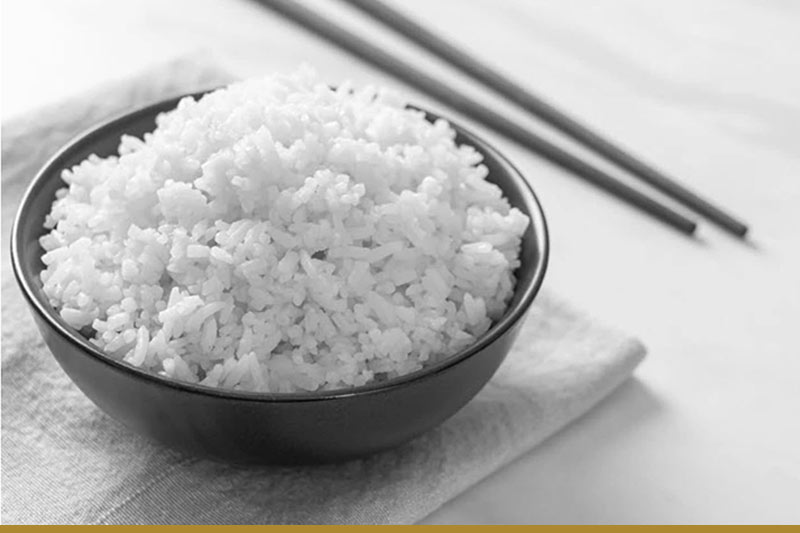Over half the world’s population consumes rice as a staple food. In Asian countries, which produce around 90% of rice, it forms the basis of almost every meal.
As such a widely consumed cereal, the question arises whether rice contributes to weight loss or causes weight gain.
This article explains the nutritional value of rice, looks different rice varieties, and recommends the best way to eat rice to achieve and maintain optimal weight.

The nutritional value of rice depends on the way it has been processed and which parts of the grain have been removed.
Like all cereals, a grain of rice has three components:
White or refined rice is rice that has had the bran and germ removed. Rice that still has these two nutritionally valuable parts is whole or brown rice. While both white and brown rice have the same amounts of calories and carbohydrates, unenriched white rice has significantly smaller amounts of vitamins and minerals.
Below is a table that compares the nutritional value per 100 grams (3.5 oz) of brown and white rice:
| White (long grain) rice | Brown (long-grain) rice | |
|---|---|---|
| B1 (thiamine) | 0.07 mg (milligrams) | 0.401 mg |
| B2 (riboflavin) | 0.049 mg | 0.093 mg |
| B3 (niacin) | 1.6 mg | 5.091 mg |
| B5 (pantothenic acid) | 1.014 mg | 1.493 mg |
| B6 | 0.164 mg | 0.509 mg |
| B9 (folate) | 8 μg (micrograms) | 20 μg |
| Calcium | 28 mg | 23 mg |
| Iron | 0.8 mg | 1.47 mg |
| Magnesium | 25 mg | 143 mg |
| Manganese | 1.088 mg | 3.743 mg |
| Phosphorus | 115 mg | 333 mg |
| Potassium | 115 mg | 223 mg |
| Selenium | 15.1 μg | 23.4 μg |
| Sodium | 7 mg | 7 mg |
| Zinc | 1.09 mg | 2.02 mg |
Source: FoodData Central (usda.gov)
Rice contains carbohydrates in two forms: starch and fiber.
Starch
Starch is a complex carbohydrate that is made up of long chains of glucose. When we eat, the starch in rice is converted into sugar, providing energy to cells. With refined rice, which has been stripped of fiber and other nutrients, this process occurs quickly and causes a rapid blood sugar spike (high glycemic index).
Rice contains two types of starch, amylose and amylopectin. Differing levels of these two starches determine whether the grains will remain separate or stick after cooking. Rice with high amylose levels (such as basmati rice) takes longer to digest and has a lower glycemic index, which is especially beneficial for people who need to watch their blood sugar levels.
Fiber
Fiber is a complex carbohydrate that is essential for overall health and weight management. Fiber takes up space in the stomach and intestine and slows down digestion. This contributes to a longer feeling of fullness, helping with portion control, and eliminating snacking.
By slowing down digestion, fiber regulates the release of glucose from food, preventing sudden sugar spikes and stabilizing levels in the blood. It also lowers the amount of fat and cholesterol that is absorbed from the food we eat. This has a positive effect on health and helps prevent conditions such as diabetes and cardiovascular disease.
Fiber is also essential for gut health because healthy bacteria in our stomach and intestine feed on it. A healthy gut improves the immune response and fights inflammation. Fiber also prevents constipation by speeding up the processing and elimination of waste.
Whole grain rice contains B complex vitamins and minerals that promote health, boost energy, and help achieve and maintain optimal weight. These essential nutrients are:
There are several types of rice with various health and weight loss benefits. All rice is gluten free and is therefore suitable for people with celiac disease and gluten intolerance.
White rice has been processed and stripped of its bran and germ. The process increases shelf life and reduces cooking time but depletes the grain of nutrients and fiber. White rice mainly consists of carbohydrates in the form of starches and is sometimes artificially enriched with B vitamins and iron.
Apart from carbohydrates, brown rice contains fiber, vitamins, and minerals. The combination of nutrients in brown rice helps you feel full longer, preventing overeating. It is especially beneficial for people with diabetes since it has a low glycemic index and doesn’t cause rapid blood sugar spikes. The nutrients contained in brown rice also decrease the risks of cardiovascular disease by lowering bad cholesterol (LDL).
Red rice is one of the most nutrient-rich of all rice varieties. It contains antioxidants and is an excellent source of iron, magnesium, calcium, and zinc. Red rice also has a low glycemic index, making it beneficial for people who wish to regulate their blood sugar levels.
Black rice (sometimes called purple rice) is another nutritionally valuable rice variety. It gets its color from the pigment called anthocyanin, which has strong anti-inflammatory and antioxidative properties and prevents heart and brain disease. Black rice also contains more fiber, protein, and iron than other varieties, besides higher levels of amino acids and fatty acids. These nutrients combine to make black rice a powerful aid in weight loss.
Jasmine rice is an aromatic, long grain rice variety mostly used in South Asian cuisines. There are several variations of jasmine rice, including white, brown, red, purple, and black rice. Brown jasmine rice is recommended for glycemic control since it decreases blood sugar levels while remaining an excellent source of energy. Colored jasmine rice varieties contain phytonutrients that have immune-boosting and antioxidant properties.
Basmati a long-grain rice variety traditionally used in Indian cuisine. It has a low glycemic index, making it suitable for diabetics and people who are mindful of their blood sugar levels. Brown basmati rice is a good source of fiber, magnesium, vitamin E, zinc, potassium and phosphorus, nutrients which help maintain health and manage weight.
Wild rice is typically found across Northern America. It’s not technically rice but an aquatic grass related to rice. Recently, wild rice has gained popularity because of its high nutritional value. Wild rice contains fewer calories that other rice varieties and is considered a complete protein (i.e., it contains all the essential amino acids). The high level of vitamins, minerals, and fiber mean that wild rice is helpful at regulating blood sugar and insulin resistance, reducing the risk of diabetes.
Brown rice is an established healthy food choice and weight-loss aid. Rice is a staple food in many countries that have historically had the lowest percentage of overweight and obese people, such as Japan, Korea, and India. In these countries, rice is typically consumed with other foods rich in protein and fiber that contribute to maintaining a healthy weight.
Brown rice is more beneficial for weight loss than white rice for several reasons.
Here are some recommendations on how best to incorporate rice in your weight-loss diet.
Whole grain rice is always the better choice for health and weight loss since it keeps its nutritional value during preparing and digestion. Colored varieties such as black, red, and wild rice are also excellent choices.
Rice is beneficial for weight loss only when it’s part of a balanced diet. For best results, you should combine it with food that is low-calorie and nutritionally dense. It is best to restrict yourself to a single serving of rice in one meal.
A variety of vegetables on your plate will satisfy your nutritional needs while being low on calories. Government recommendations are that half your plate be filled with different vegetables.
When you eat rice with food lacking in proteins, you may feel hungry sooner. To prevent this, combine rice with healthy protein sources such as beans and pulses, tofu, lean meat, and fish.
Keep in mind that the way you prepare food impacts its nutritional value and that overcooking can strip food of its nutrients. Rice is best prepared by boiling or steaming instead of frying.
When rice is combined with other food, watch the added calories. For example, sushi contains sugar and vinegar, which may contribute to cravings. Risotto is prepared with butter and cheese, which significantly up the calorie count of your meal.
Whole grain rice is a highly beneficial grain packed with vitamins, minerals, and fiber. In combination with other healthy foods, rice can form part of a weight-loss regimen.
Whole grain rice is rich in nutrients and fibers contributing to your health and can prevent heart disease and diabetes. For efficient and long-lasting weight loss results, make healthy rice variants a frequent part of a balanced diet.




4325 E Indian School Rd, Suite 130
Phoenix, AZ 85018
United States
(480) 422-2058
info@vibrantvitalityclinic.com
Monday - Friday: 9:00 am - 6:00 pm
Saturday: 9:00 am - 3:00 pm
Sunday: Closed
